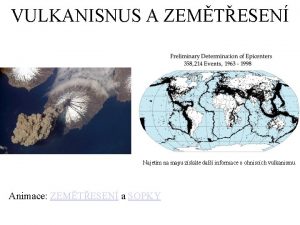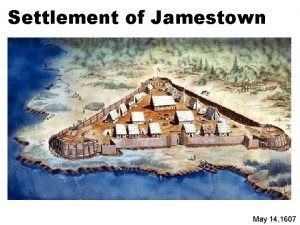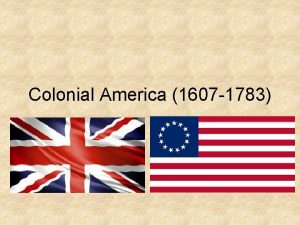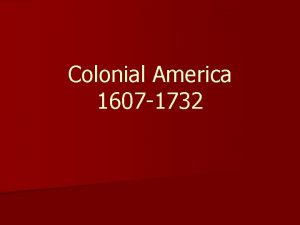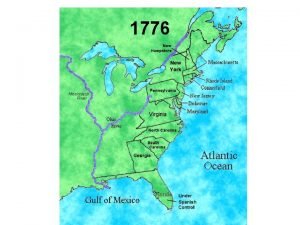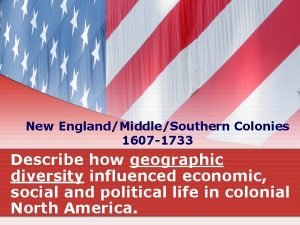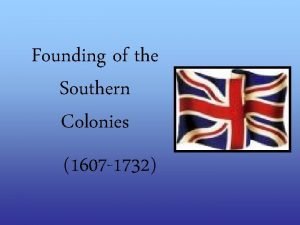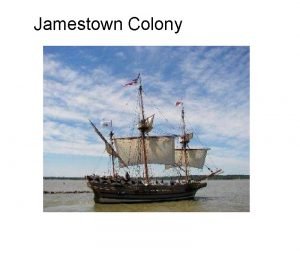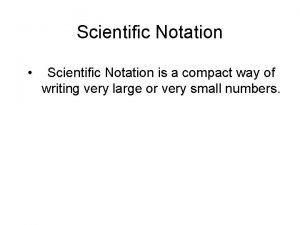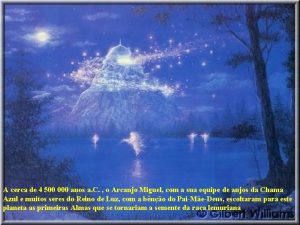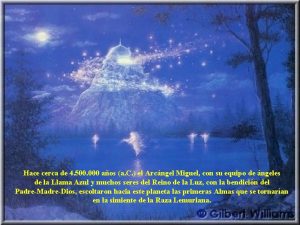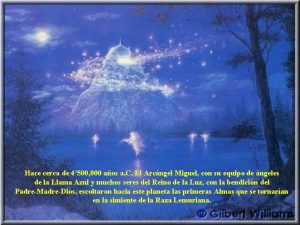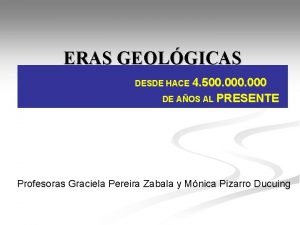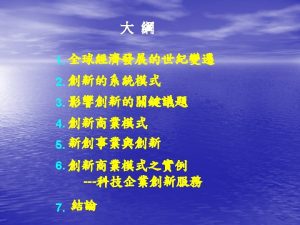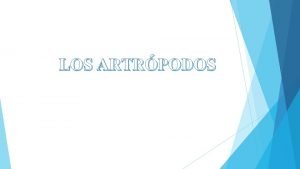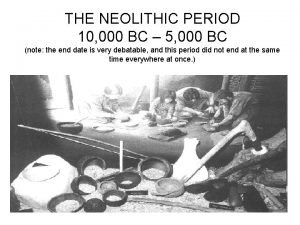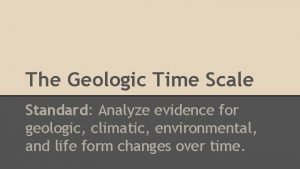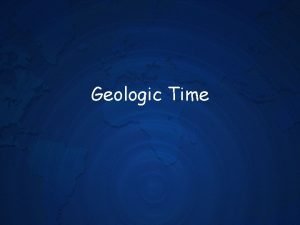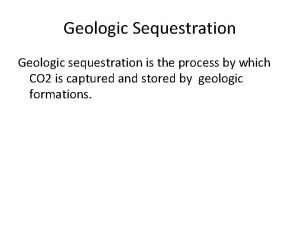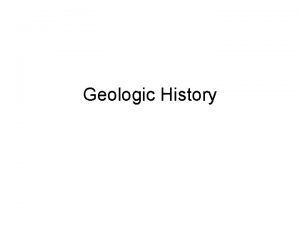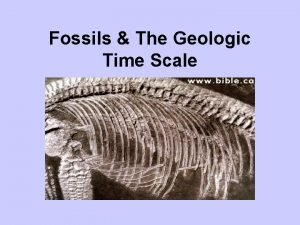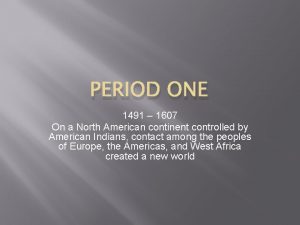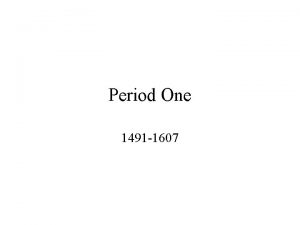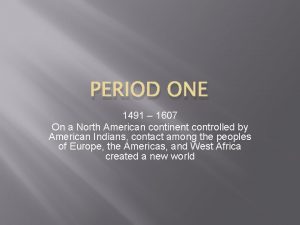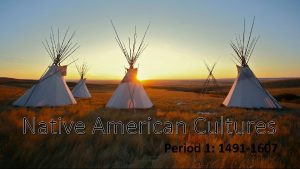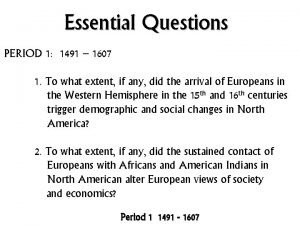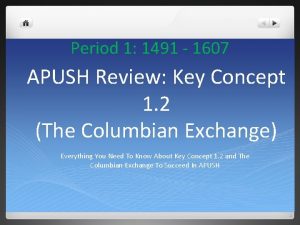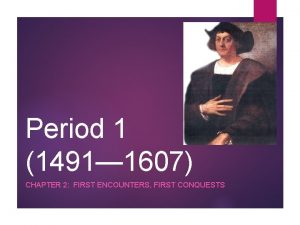Period One 1491 1607 Geologic Timeline 10 000













































- Slides: 45

Period One 1491 -1607

Geologic Timeline • 10, 000 years ago – Canadian Shield rises above sea level • 35, 000 years ago – Land Bridge from Siberia to Alaska “opens” • 25, 000 – 17, 000 years ago – Migration takes place over the land bridge • 10, 000 years ago – Land Bridge from Siberia to Alaska “closes” • Think about migration. Why did they leave?

The Civilizations of America …advanced societies were developing in isolation in the Americas While classical civilizations were developing in the Mediterranean & Asia…

• Text During the Neolithic Title Revolution, these nomads settled into farming villages; Some of which became advanced civilizations During the Ice Age, prehistoric nomads migrated across the land bridge between Asia & America

• Pre. Columbian time period. • First Americans came from Asia • Crossed the Bering Strait during the Ice Age • Following a food source • Gradual migration

Early Human Migrations 1 st Migration, 38, 000 -1800 BCE 2 nd Migration, c. 10, 0004, 000 BCE

The “Land Bridge” Theory As the Great Ice Age diminished, so did the glaciers over North America. The theory holds that a “Land Bridge” emerged linking Asia & North America across what’s today the Bering Sea. People were said to have walked across the “bridge” before the sea level rose and sealed it off and thus populated the Americas. The Land Bridge is suggested as occurring an estimated 35, 000 years ago. Many peoples emerged… Those groups that traversed the land bridge spread across North, Central, and South America. Countless tribes emerged with an estimated 2, 000 languages. Notably… Incas – Peru, with elaborate network of roads and bridges linking their empire. Mayas – Yucatan Peninsula, with their step pyramids. Aztecs – Mexico, with step pyramids and huge sacrifices of conquered peoples.

"TEACHING MEASURES OF TIME The usage of B. C. E. (Before the Common Era) and C. E. (Common Era) as replacing the exclusively Christian dating of B. C. (Before Christ) and A. D. (Anno Domini or After Death). You should also make sure you are familiar with the names of the centuries and their dates; i. e. , the year 1492 was in the fifteenth century. "

Development of Corn Development of corn or “maize” around 5, 000 B. C. in Mexico was revolutionary in that… • Then, people didn’t have to be huntergatherers, they could settle down and be farmers. • This fact gave rise to towns and then cities. • Corn arrived in the present day U. S. around 1, 200 B. C. • Took along time to spread to present day U. S.

Cultures of North America Class Discussion: What caused these different regions ? Are there any intervening obstacles that caused these different regions. The slowness of the northward spread of corn resulted in less sophistication than those in Mexico and South America.

How did landscape, climate and resources influence the development of Native Americans society. Write for 10 minutes answering this question.

Exploration Before Columbus By the time Christopher Columbus landed in the Western Hemisphere in 1492, the New World had already been “discovered” more than once. First, of course, there were the Native Americans we discussed in the previous section. But there is solid evidence that other Europeans made it to the Americas long before Columbus did. • Around A. D. 1000, Viking Norsemen led by Leif Ericson sailed from Norway across the Atlantic Ocean and settled in Newfoundland, in northeast Canada. • These Vikings also explored some distance up and down the coast. • This settlement, however, was short-lived. • The Norsemen soon sailed back across the ocean, having had little to no effect on North America.

Big Picture Question? What factors made an oceanic crossing and exploration possible in the late 1500 s?

Europe Moves toward Exploration What factors made an oceanic crossing and exploration possible in the late 1500 s? • The Renaissance • Better Maps • Caravels/Better shipbuilding techniques • Better use of gunpowder • Compass • Mariner's Astrolabe • Gutenberg’s printing press

Europe Moves toward Exploration Spain’s Banner Year - The later years of the Renaissance were a time 1492 of intense religious zeal • The last Moorish stronghold is and conflict. The Roman defeated at the Battle of Grenada. Catholic Church that had • Queen Isabella of Castile and King once dominated Western Ferdinand of Aragon funded Christopher Columbus on his Europe was threatened historic first voyage and “discovers from the Ottoman Turks America”. who were followers of • All of these events signaled new Islam and from within by a leadership, hope and power for revolt against the Pope’s Europeans who followed the Roman authority. Catholic religion.

Europe Moves toward Exploration The Protestant Reformation • The Protestant Reformation was the breakoff from the Roman Catholic Church within Western Christianity initiated by Martin Luther, John Calvin, and other early Protestants. • Although there had been significant attempts at reform before Luther, the date most usually given for the start of the Protestant Reformation is 1517, when Luther published The Ninety -Five Theses. • Reasons? Why • It led to the creation of new national Protestant churches. • The largest of the new churches groupings were the Lutherans (mostly in Germany • the Baltic’s and Scandinavia) • Reformed churches (mostly in Germany, France, Switzerland, the Netherlands and Scotland).

Direct Causes = 3 G’s • Religious: spread Christianity and weaken Middle Eastern Muslims. (GOD) • Economic: Search for new trade routes with direct access to Asian/African luxury goods would enrich individuals and their nations (GOLD) • Political: Become a world power through gaining wealth and land. (GLORY) The 3 motives reinforce each other

Expanding Trade Economic motives for exploration grew out of fierce competition among Europeans Kingdoms for increased trade with Africa, India and China. The land route had become blocked in 1453 when the Ottoman Empire seized control of Constantinople. Islam controls route East • Spices, silk, & tea introduced to Europe via the Crusades (1000 AD) • 1400 AD – Islam controls Middle East, Italy becomes middle man in trade • Portugal seeks “short cut” around Africa • Begins trade in gold and slaves with African states, slowly moves down the coast • Henry the Navigator • Dias reaches Cape of Good Hope in 1488 • da Gama reaches India via ship in 1496

Expanding Trade • European planters turned these Seeking a maritime route to the riches Atlantic islands into laboratories for of the trans-Saharan trade routes, cash crops, including sugar cane, Prince Henry of Portugal (1394– 1460) wheat, wine grapes, and woad, a blue established a naval academy. • dye plant. Portuguese sailors developed a new In the Canary Islands, Castilian ship, the caravel, rigged with a lateen adventurers used Guanches, the or triangular sail. • natives of the islands, as their This innovation, which allowed for enslaved labor force. better and longer-distance sailing in By 1500, Madeira sugar became the treacherous waters off the available in small, expensive quantities northwest African coast, led to the in London, Paris, Rome, and discovery and colonization of the Constantinople. Madeira and Azore islands. • From there, they sailed in 1435 to sub -Saharan Sierra Leone, where they traded salt, wine, and fish for African gold and ivory.

Expanding Trade • Initially the Portuguese carried a few thousand African slaves each year to work on sugar plantations in the Cape Verde Islands, the Azores, and the Madeira Islands; they also sold slaves in Lisbon, which soon had an African population of 9, 000. • After 1550, the Atlantic slave trade expanded enormously as other Europeans joined West Africa’s longestablished trade in humans and forcefully shipped hundreds of thousands of slaves to new American sugar plantations in Brazil and the West Indies.

European trade routes

Important Names in The Age of Exploration Name Country Achievement(s) Christopher Columbus Spain 1492: Reached Bahamas; explored Cuba, Haiti 1493: Established Santo Domingo John Cabot England 1497/8: Claimed Nova Scotia, Newfoundland for England Amerigo Vespucci 1499: Explored coast of S. America for Spain, Portugal 1501: Explored coast of S. America for Portugal Ponce de Leon Spain 1513/21: Explored Florida Ferdinand Magellan Spain 1519: Began the first circumnavigation of the globe Hernando Cortez Spain 1519– 1522: Conquered the Aztecs in Mexico Francisco Pizarro Spain Hernando de Soto Spain 1530– 1536: Conquered the Incas in Peru 1539– 1542: Explored coast between Mississippi River and Florida Jacques Cartier France 1542: Traveled St. Lawrence River to Montreal Samuel de Champlain France 1608– 1615: Explored Great Lakes, founded Quebec, established fur trade with Native Americans Henry Hudson Netherlands 1609– 1611: Sailed up Hudson River The Major Players in the Age of Exploration The individual explorers often get the glory, but for the APUSH exam, it is more important that you know the broader context: the nations that sponsored those explorers; the reasons those nations were so interested in exploring and settling the New World; and the geographical territories that each nation claimed as its own. Don’t get me wrong: familiarity with the individual explorers is helpful (that’s why I gave you the chart), but you should understand the explorer’s contributions within the larger context of the age.

Christopher Columbus The Spanish monarchy began the Age of Exploration when it sponsored Christopher Columbus’s journey westward, across the Atlantic Ocean, in search of Asia. Columbus failed to reach Asia, landing instead on the Bahama Islands in 1492. He returned to the New World in 1493 and established the settlement of Santo Domingo as a base for further exploration

NEW WORLD OLD WORLD



Columbian Exchange – food (old vs. new)!

Columbian Exchange – animals & diseases

Treaty of Tordesillas 1494 • In 1493, the Pope declared that all lands west of the Azores and the Cape Verde Islands belonged to Spain, but Portugal, another great sea power, disputed the papal decree. • The two countries reached a compromise with the Treaty of Tordesillas in 1494, which divided all future discoveries between Castile (a region of Spain) and Portugal. • The Treaty of Tordesillas reveals that both Portugal and Spain led the charge in exploring the New World. • But while the Portuguese focused on navigation and geographical observation, the Spanish put their efforts into expedition and colonization.

Spanish Exploration and Conquest • After the Treaty of Tordesillas, Spain quickly established itself as the premier European power in the New World, sending wave after wave of explorers into South America. • These Spanish expeditions, led by conquistadors, set out in search of gold, slaves, lucrative trade routes, and fame. Indeed, they succeeded in creating an enormous empire. • By 1522, the Spaniard Hernando Cortez had conquered the Aztecs in Mexico and by 1536, under the leadership of Francisco Pizaro, Spain had conquered the Incas in Peru.

Spanish Exploration and Conquest • Conquistadors plundered the indigenous tribes for treasure and slave labor. • They established numerous encomiendas—sprawling estates populated with native slaves. • Under Conquistador rule, many of the natives died from disease, malnutrition, and fatigue, and they were soon replaced on the encomiendas by African slaves brought in by Portuguese slave traders.

Spanish Exploration and Conquest Hernando Cortez conquered the Aztecs at Tenochtitlan. Cortez went from Cuba to present day Vera Cruz, then marched over mountains to the Aztec capital. Montezuma, the Aztec king, thought Cortez might be the god Quetzalcoatl who was due to re-appear that very year. Montezuma welcomed Cortez into Tenochtitlan. The Spanish lust for gold led Montezuma to attack on the noche triste, sad night. Cortez and men fought their way out, but it was smallpox that eventually beat the Indians. The Spanish then destroyed Tenochtitlan, building the Spanish capital (Mexico City) exactly on top of the Aztec city. A new race of people emerged, mestizos, a mix of Spanish and Indian blood.

Spanish Exploration and Conquest • The Spanish invasion changed life forever in the Americas. • Disease and warfare wiped out virtually all of the Indians of Hispaniola—at least 300, 000 people. • Peru’s population of 9 million in 1530 plunged to fewer than 500, 000 a century later. • The decline of Mesoamerica’s population from 20 million in 1500 to just 3 million in 1650 represented one of the great demographic disasters in world history.

Spanish Exploration and Conquest • In North America, Spain initially proved just as dominant. Ponce de Leon claimed Florida for Spain in 1513, and Hernando de Soto led a Spanish exploration of the southeastern United States in 1539, discovering the Mississippi River. • In 1565, Spain established the first successful European settlement in North America—a fortress in St. Augustine, Florida. • Around the turn of the seventeenth century, Spanish settlers moved into the Southwest, establishing the colony of Santa Fe in 1610.

English Claims • Compared to other European powers, England got a relatively late start in the exploration and colonization of the New World. True, King Henry VII of England did send explorer John Cabot across the Atlantic in 1497, and Cabot claimed Nova Scotia, Newfoundland, and the Grand Banks for England. • But after Cabot’s efforts, the English became more concerned with domestic issues and generally ceased exploring. • For much of the sixteenth century, England had no real presence in the New World.

English Claims • England’s first effort to establish a settlement in the New World ended badly. • In 1584, Sir Walter Raleigh gained a royal charter to found the settlement of Roanoke, located on an island off the coast of North Carolina. Raids by Native American tribes and disease devastated the settlement, and it was eventually abandoned. • Still, the Spanish monarchy, determined to eliminate their New World rivals, dispatched the great Spanish Armada in 1588 to attack the British off the coast of England. • Through luck and ingenuity, a fleet of outgunned English ships decimated the Armada. • With this victory, England began its ascent as a premier naval power, which bolstered its colonial efforts, and Spain fell into a slow decline.

English Claims • The struggle between Britain and Spain dragged on throughout the end of the sixteenth century, so that by 1600 the English crown and Parliament were hesitant to spend money on colonization. • In place of government funding, jointstock companies formed to gather funding for colonization through the sale of public stock. • Along with religious groups—who saw the rise of the English navy as a real opportunity to move to the New World and escape religious persecution—these joint-stock companies were responsible for most English colonization throughout the seventeenth century.

French Claims • France also played a strong role in the New World, though its efforts were mainly confined to North America. • The French led the charge to find a Northwest Passage, a much-hoped-for water route through which ships might be able to cross the Americas to access Asia. • In three voyages between 1534 and 1542, French explorer Jacques Cartier traveled the St. Lawrence River as far as Montreal.

French Claims • Despite its failures, France continued to be a major player in North America. • Most notably, the French engaged in the highly profitable fur trade, setting up trading outposts throughout Newfoundland, Maine, and regions farther west. • Samuel de Champlain founded the first permanent French settlement in 1608 at Quebec, and established a fur trade with the region’s Native American tribes. • By the end of the seventeenth century the French controlled the St. Lawrence River, the Mississippi River, the Great Lakes and, therefore, much of the land in the heart of the continent. • Of all the European colonial powers, the French enjoyed the best relationship with Native Americans.

Samuel de Champlain was the founder of Quebec City, the first permanent French settlement in North America in 1608 French explorers French priest Jacques Marquette and fur trader Louis Joliet explored the Great Lakes and upper Mississippi River Valley La. Salle (1683 ish) explored the lower Mississippi River, claiming the entire valley for France, naming it “Louisiana” in honor of Louis XIV 42

The Coureurs De Bois (Runners of the Woods) – New France was built on the beaver skin trade. – Young beaver trappers (coureurs de bois or “runners of the woods”) paddled canoes into trapping lands, worked with the Indians, and hauled out their beaver skins for sale. – They were also known as voyageurs. – Their Indian friends were decimated by the whites’ diseases. – The beaver population eventually began to run thin. – Important areas founded: Detroit. Ohio Valley-To Check Spain in Florida, La. Salle settles the Gulf of Mexico

Dutch Claims • The Dutch East India Company became interested in North American settlement in 1609, when Henry Hudson sailed up the river that now carries his name. • In 1625, the Dutch bought Manhattan island from the natives who lived there and established the settlement of New Amsterdam at the mouth of the Hudson River. • While the colony flourished on account of the fur trade, the Dutch did little to expand their landholdings beyond their domain around the Hudson. • A European conflict between England the Netherlands spread to the New World in 1664, during which the English took over New Amsterdam, renaming it New York. After 1664, Dutch influence waned.

Effects of Colonization on the Natives • Colonization had a disastrous effect on the native population. War, slavery, and starvation claimed many lives, but disease, especially smallpox, had the most devastating effect. • In present day Mexico, the native population plummeted from 25 million in 1519 to 2 million by 1600. European settlement physically displaced numerous tribes, setting in motion the sad fate of Native Americans throughout American history. • The Spanish, however, provided the Native Americans of the Great Plains with an unintended gift: horses. • During the conquistadors’ expeditions into the Southwest, some horses escaped and formed large herds on the Great Plains. • Within a few generations, Native Americans in the plains region became experts on horseback, expanding their hunting and trading capabilities and dramatically transforming Native American culture.


Big Idea: How did the political, economic and religious systems of Native Americans , Europeans and Africans compare and how did things change as a result of contacts among them? You must be able to answer this question… Compare Change • All were dependent on • All became dependent on each agriculture for trade • All had some form of religion • Diseases ravished Native Brainstorm your Americans answers • All had a ruling class and subjugated people • Africans taken mostly from Western Africa, fueled warfare along the coast • Europe benefited most from Columbus’ discovery
 1491 to 1607 timeline
1491 to 1607 timeline 97 700 000 000 000 000 000 000 in scientific notation
97 700 000 000 000 000 000 000 in scientific notation Express 602200 in scientific notation.
Express 602200 in scientific notation. 33 900 000 in scientific notation
33 900 000 in scientific notation Compare geologic time with the geologic column.
Compare geologic time with the geologic column. 090-0000-0000
090-0000-0000 Sopka na islandu s nadmořskou výškou 1491 m.n.m
Sopka na islandu s nadmořskou výškou 1491 m.n.m Expansion of the united states of america 1607 to 1853 map
Expansion of the united states of america 1607 to 1853 map Số la mã
Số la mã May 14 1607
May 14 1607 1783-1607
1783-1607 1732-1607
1732-1607 1776-1607
1776-1607 1733-1607
1733-1607 1607-1732
1607-1732 King james jamestown
King james jamestown Blood on the river jamestown 1607
Blood on the river jamestown 1607 Express 4,980,000, 000 in scientific notation.
Express 4,980,000, 000 in scientific notation. 7x10x10x10
7x10x10x10 2,340,000,000
2,340,000,000 2340000000
2340000000 110 000 110 & 111 000 111
110 000 110 & 111 000 111 1 100 1000 10000
1 100 1000 10000 Advantages of scientific notation
Advantages of scientific notation 4 500 000
4 500 000 1 000 000 0000
1 000 000 0000 3 868 000 000 in scientific notation
3 868 000 000 in scientific notation 450 scientific notation
450 scientific notation Scientific notation rules
Scientific notation rules Https://portal.office.com
Https://portal.office.com 1,000 x 3,000
1,000 x 3,000 Cancion lemuriana
Cancion lemuriana 4 500 000 000
4 500 000 000 4 500 000
4 500 000 260 000 000
260 000 000 27x10^3 in scientific notation
27x10^3 in scientific notation Pedipalpos quelados
Pedipalpos quelados 60 000 000
60 000 000 4 000 000
4 000 000 10 000 bc time period
10 000 bc time period How is the geologic time scale organized
How is the geologic time scale organized Graphic organizer about geologic time scale
Graphic organizer about geologic time scale Geologic time calendar
Geologic time calendar Caprock
Caprock Original horizontality definition
Original horizontality definition Geologic time scale animals
Geologic time scale animals






